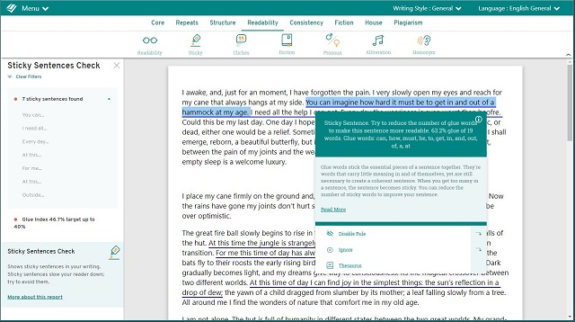As writers, we spend a lot of time thinking about our story and our characters. We agonize over plot points and think about how to create heroes and heroines that our readers will love. We meticulously review the structure of our scenes, trying to keep our readers surprised and engaged. But we often skip right over one of the most important aspects of writing: the clarity of our prose. If your writing isn’t clear, your work won’t engage readers. They will spend more time trying to figure out what you’re saying than actually engaging with your ideas.
As a writer, your main job is to get your meaning across clearly and effectively. That means if your writing is too complicated or if it’s hard to follow, you’re not doing your job. Good writing isn’t about showing off your fancy vocabulary. It’s about enabling your readers to understand what you’re trying to say through your sentence structure and word choice.
How do you improve the clarity of your writing? It all comes down to how you set up your sentences and what words you choose. Here are three tips to make your writing clearer.
1. Keep sentences short and simple
Long, winding sentences are exhausting for readers, especially if you have many longer sentences in a row. Create a pleasant reading experience by keeping most of your sentences short, simple, and to the point.
One way to shorten your sentences is to eliminate glue words. Glue words are the 200 or so most common words in the English language, words like articles, conjunctions, and prepositions. Every sentence needs glue words: they help the sentence make sense. But if you have too many glue words, your sentence becomes sticky.
Sticky sentences are tough on readers; they’re often overly long and full of unnecessary words that don’t add anything to their meaning. Here’s an example:
Marshall was able to use the information that he had in his files and speak to a number of people about the problem and then come to a solution about the problem.
This sentence is sticky—it has too many glue words, which makes it hard to read. Consider this rewrite:
Marshall used the information in his files and from his contacts to find a solution for the problem.
Much clearer and easier to understand! While both sentences are grammatically correct, the first is overly wordy and frustrating. The second is straight to the point, creating a better reading experience.

ProWritingAid’s Sticky Sentences check helps you identify glue words in your writing.
2. Target an appropriate readability level for your audience
Many writers think that challenging writing is good writing. Not so! It might sound counterintuitive, but the best authors make their writing easier to read, not harder.
That’s because most adult readers actually prefer their books to be easy to read, especially if they’re reading for pleasure. In fact, most mass market fiction books are written at a seventh grade reading level, meaning the language in those books could be understood by an eleven-year-old.
Before we go any further, it’s important to note that readability has nothing to do with ideas. It’s only about word choice and sentence structure. You can write a book with complex, adult ideas and simple, easy-to-understand sentences. In fact, it might be more important to use simple sentences if your ideas are complex. That way, readers don’t misunderstand your meaning.
Readability is a sliding scale, so the readability score you target will change depending on what you write. If you’re writing mass market fiction, then seventh grade is probably an appropriate reading level to strive for. If you’re writing an academic paper, your writing may be at a twelfth grade level or higher. It all depends on your audience.
You can check your readability by running your work through a readability calculator to determine your readability score. A readability score measures factors like sentence length and word familiarity to predict whether a certain level of reader will understand your writing.
There isn’t just one way to improve readability, but if your score doesn’t match your target audience, you might ask yourself these questions:
- Am I using easy-to-understand vocabulary?
- Are my sentences short and to the point?
- Am I using too much jargon?
- Am I writing in the active voice?
Each of these factors may help improve your readability score.

The Readabilty Report from ProWritingAid highlights paragraphs that are difficult to read and might need your attention.
3. Choose specific and vivid words
Clarity isn’t just about writing short, simple sentences or making your writing more readable. The words that you do choose to include in your writing need to give your readers key information.
Vague words are unclear—they don’t give your reader what they need to really understand your meaning. For instance, did you describe your protagonist as a short woman? Short is subjective: it means something different to every person.
Many writers use vague words without realizing that those words negatively impact readers. Words like excellent, some, better, large, or considerable are all subjective. They don’t add anything to your readers’ understanding. Even worse, these vague words may lead your readers to disengage from your writing entirely.
Take the following sentence:
Jim made some improvements to his house and now it’s worth more.
That sentence is too vague. “Some improvements” can mean anything from repainting the garage to installing an entire new floor. Similarly, “worth more” might mean ten dollars or it might mean ten thousand dollars.
Here’s a better example:
Jim installed hardwood floors in his living room, which increased the value of his home by $5,000.
Much clearer! Now, you can picture exactly what Jim did to improve his home.
Want to learn more about improving the clarity of your writing?
On Tuesday June 29th, Hayley Milliman, Head of Education at ProWritingAid, will be conducting an online workshop called The Five Principles of Creating Clarity: How to Ensure Your Writing is Engaging, Reader-Focused, and Easy to Understand. You can sign up here.
She will walk us through the writing techniques behind ProWritingAid’s reports and then she will answer your questions about improving clarity and using the ProWritingAid tool. We hope to see you there!

As Head of Education at ProWritingAid, Hayley Milliman focuses on building engaging, helpful learning content for the millions of users who rely on ProWritingAid to make their writing clear and effective. Hayley has a robust writing portfolio and has written for dozens of publications on topics related to education, marketing strategy, history, entrepreneurship, and more. She has also published several books related to writing and history, one of which hit the Amazon bestseller list. When not working, Hayley loves hiking, skating of all kinds, and correcting people on Star Wars trivia.







